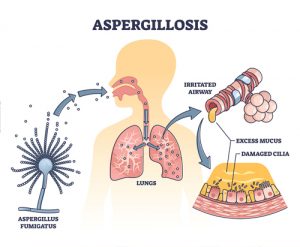WORDS DR LOW LEE LEE
 FEATURED EXPERT FEATURED EXPERTDR LOW LEE LEE Infectious Disease Physician Sultanah Bahiyah Hospital |
FUNGI: OUR FRIENDS & FOES (IT’S COMPLICATED)
Fungi are found naturally in our environment. There are many different types of fungi, over 2 million species however about 600 fungi have caused diseases.
Invasive fungal infections typically manifest as a severe and aggressive form of the disease, leading to corresponding to high prevalence and death rates if left untreated.
These infections include invasive mold infections.
INVASIVE MOLD INFECTIONS AT A GLANCE
- Usually caused by Aspergillus (giving rise to invasive aspergillosis) but can also be caused by other rarer molds such as Mucormycetes (giving rise to mucormycosis).
- These molds produce spores; most of us encounter these spores every day without getting ill, but people with compromised immune systems may develop complications as a result of these spores.
- Despite invasive aspergillosis and mucormycosis being relatively uncommon, invasive mold infections are often life threatening. If left untreated, the mortality rates can reach 100%!
- Various parts of the world reported superinfections of invasive aspergillosis and mucormycosis in patients with COVID-19, which are associated with increased risk of death. COVID-19 likely increases the risk for fungal infections because it weakens the immune system or due to certain therapies used for treatment such as steroids.
- There are no specific symptoms, as symptoms can vary depending on the type of infection. This makes diagnosis an infection a challenging and sometimes complicated task!
Invasive Aspergillosis

- Invasive aspergillosis is uncommon and occurs primarily in immunocompromised people.
- Commonly seen in people that have undergone stem cell and other organ transplants (especially lung transplant), as well as in patients with blood-related cancers such as acute leukemia.
- Typically affects the lungs, but it can also spread to other parts of the body.
Mucormycosis
- Mucormycosis is rare and estimated to affect approximately 10,000 cases worldwide, barring India. If India is included the numbers rise to 910,000 cases annually!
- Typically occurs in the sinuses of the nose or lungs; however it can spread to the brain and other organs as well.
COMMON SYMPTOMS OF A POSSIBLE INVASIVE MOLD INFECTION |
|
HOW TO REDUCE YOUR RISK OF AN INVASIVE MOLD INFECTION |
|


